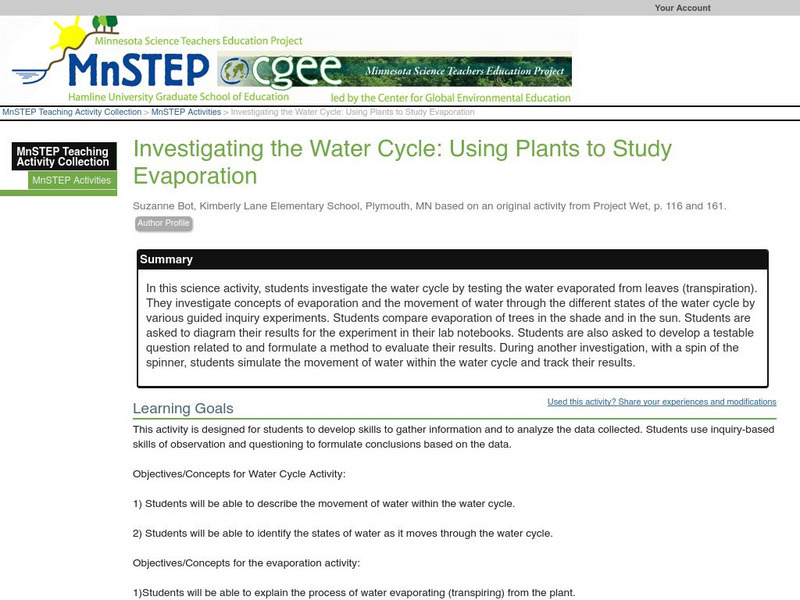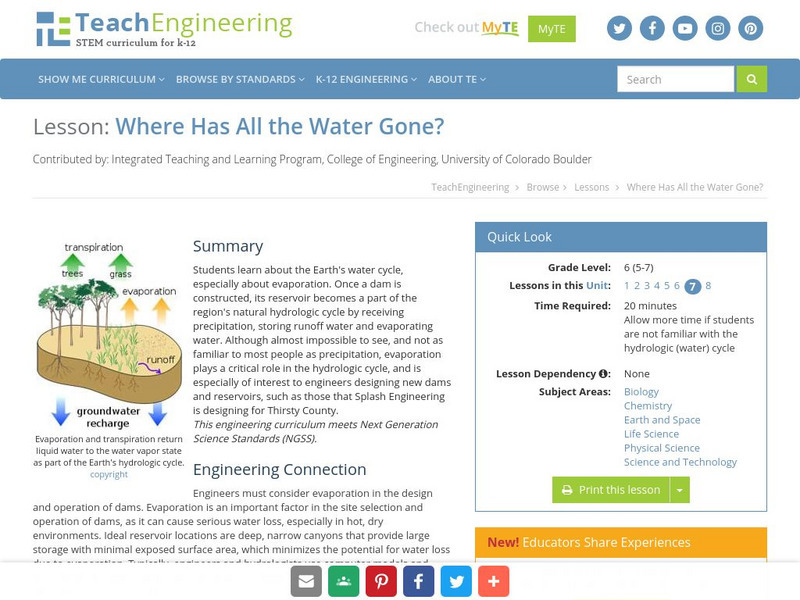Curated OER
Clouds as Art: Torn Paper Landscape
Students create a torn paper landscape and use it to study clouds. In this cloud study and art lesson, students make a background art image from torn paper. Students create a torn paper landscape and use cotton balls to illustrate...
Curated OER
San Francisco Bay Watershed
Students locate important landmarks on a map and explore the watersheds in California. In this watershed lesson students complete a worksheet and discuss what they learned.
Curated OER
How Does Your Garden Grow?
Students create a design for a school garden. In this garden design lesson plan, students analyze what plants grow best in their school's climate and work in teams to design a garden. Students measure the existing space, determine the...
Curated OER
Frozen Film
Students are introduced to the topic of light interference through this hands-on activity. They observe how light reflects off two surfaces and then meets to form an interesting variation of color on a film surface.
Curated OER
DAY AND NIGHT
Students use a lamp as the sun and his/her body as the earth. They rotate in different directions to explain how the earth moves around the sun. Using specific questions in their discussion, students discover the reasons for day and night.
Curated OER
Tree Friends
Students are introduced to tree structure and use. They identify their special tree using all senses except sight. Students identify six different internal parts within a cross section of tree trunk (bark, phloem, xylem, cambium,...
Curated OER
Miller-Urey Experiment Amino Acids & The Origins of Life on Earth
Learners study the Miller-Urey Experiment including its history and criticism. In this origins of life lesson students repeat this experiment to see how it works.
PBS
Pbs Learning Media: The Sun and the Water Cycle
Learn about the water cycle through the adventures of two sisters. They will explain how the sun powers the water cycle and describe the different states of water. A glossary and labeled illustrations accompany the video. For the...
Science Education Resource Center at Carleton College
Serc: Investigating the Water Cycle: Using Plants to Study Evaporation
In this science activity, students investigate the water cycle by testing the water evaporated from leaves (transpiration). They investigate concepts of evaporation and the movement of water through the different states of the water...
Science Education Resource Center at Carleton College
Serc: Investigating the Water Cycle: Evaporation
In this water cycle activity, students investigate the evaporation process by participating in an outdoor evaporation experiment held on the school grounds. Students will determine where evaporation takes place the fastest and how nature...
Utah Education Network
Uen: Water Cycle Relay Race Usu Water Cycle
Students will review the water cycle through a relay race vocabulary game.
Utah Education Network
Uen: Water Cycle Drama: Usu Water Cycle
Learn the different parts of the water cycle.
Utah Education Network
Uen: Water Cycle
Activities demonstrate how the water cycle maintains itself.
Utah Education Network
Uen: Trb 4:1 Investigation 5 the Water Cycle Model
Demonstration helps students understand the water cycle.
Utah Education Network
Uen: A Water Cycle Chamber
Activity helps with understanding the water cycle.
Utah Education Network
Uen: Miniature Water Cycles
Fourth graders will construct a model of the water cycle in action.
Science Buddies
Science Buddies: Make a Water Cycle Model
In this lesson, students will explore how water is continually cycled among land, the oceans, and the atmosphere.
Science Education Resource Center at Carleton College
Serc: Investigating the Water Cycle "Snow Fun"
In this teacher directed inquiry indoor lab young scholars collect snow in a cup. They will estimate how much water will be in the cup after the snow melts. Students will then make predictions about what will happen to the cup of water....
University Corporation for Atmospheric Research
Ucar: The Water Cycle
This site provides a comprehensive introduction to the water cycle. Students construct a model to simulate parts of the water cycle. Includes background information, links to standards, lesson plans, and assessment ideas.
Alabama Learning Exchange
Alex: Water Cycle Model
This hands-on model of the water cycle is a great culminating activity for a study of the movement of water through the environment. Completed in small groups or as a class project, it involves connecting three bottles to demonstrate the...
Alabama Learning Exchange
Alex: The Water Cycle
This is an introductory lesson on the water cycle. The internet will be used to help teach the cycle. The student will end the lesson by making his/her own water cycle for observation.This lesson plan was created as a result of the Girls...
Success Link
Success Link: Water Cycle
A lesson plan to show young scholars' understanding of the water cycle through illustrations, and their ability to write creatively about it.
Alabama Learning Exchange
Alex: The Water Cycle
This is a hands applied lesson plan to help students experience the water cycle on a smaller scale. Because of the hands-on nature of the lesson, it works well to help students with a language barrier understand complicated vocabulary.
TeachEngineering
Teach Engineering: Where Has All the Water Gone?
Students learn about the Earth's water cycle, especially about evaporation. Once a dam is constructed, its reservoir becomes a part of the region's natural hydrologic cycle by receiving precipitation, storing runoff water and evaporating...


















